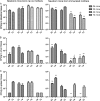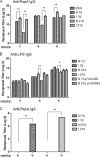Immunogenicity of a live recombinant Salmonella enterica serovar typhimurium vaccine expressing pspA in neonates and infant mice born from naive and immunized mothers
- PMID: 20053873
- PMCID: PMC2837964
- DOI: 10.1128/CVI.00413-09
Immunogenicity of a live recombinant Salmonella enterica serovar typhimurium vaccine expressing pspA in neonates and infant mice born from naive and immunized mothers
Abstract
We are developing a Salmonella vectored vaccine to prevent infant pneumonia and other diseases caused by Streptococcus pneumoniae. One prerequisite for achieving this goal is to construct and evaluate new recombinant attenuated Salmonella vaccine (RASV) strains suitable for use in neonates and infants. Salmonella enterica serovar Typhimurium strain chi9558(pYA4088) specifies delivery of the pneumococcal protective antigen PspA and can protect adult mice from challenge with S. pneumoniae. This strain is completely safe for oral delivery to day-old and infant mice. Here we assess the colonizing ability, immunogenicity, and protective efficacy of chi9558(pYA4088) in neonatal mice. Colonization was assessed in mice 0, 2, 4, or 7 days of age after oral inoculation. In the presence of maternal antibodies, the colonization of lymphoid tissues was delayed, but the immune responses were enhanced in mice born to immunized mothers. Both oral and intranasal routes were used to assess immunogenicity. All orally or intranasally immunized neonatal and infant mice born to either immunized or naïve mothers developed PspA-specific mucosal and systemic immune responses. Mice born to immunized mothers produced higher titers of PspA-specific antibodies in the blood and mucosa and greater numbers of PspA-specific interleukin-4 (IL-4)-secreting cells than mice born to naïve mothers. More importantly, mice born to immune mothers showed a significant increase in protection against S. pneumoniae challenge. These results suggest that strain chi9558(pYA4088) can circumvent some of the limitations of the immature immune system in neonatal and infant mice, generating enhanced protective immune responses in the presence of maternal antibodies.
Figures





Similar articles
-
Evaluation of new generation Salmonella enterica serovar Typhimurium vaccines with regulated delayed attenuation to induce immune responses against PspA.Proc Natl Acad Sci U S A. 2009 Jan 13;106(2):593-8. doi: 10.1073/pnas.0811697106. Epub 2008 Dec 29. Proc Natl Acad Sci U S A. 2009. PMID: 19114649 Free PMC article.
-
Immune responses to recombinant pneumococcal PspA antigen delivered by live attenuated Salmonella enterica serovar typhimurium vaccine.Infect Immun. 2002 Apr;70(4):1739-49. doi: 10.1128/IAI.70.4.1739-1749.2002. Infect Immun. 2002. PMID: 11895935 Free PMC article.
-
PspA family fusion proteins delivered by attenuated Salmonella enterica serovar Typhimurium extend and enhance protection against Streptococcus pneumoniae.Infect Immun. 2009 Oct;77(10):4518-28. doi: 10.1128/IAI.00486-09. Epub 2009 Aug 17. Infect Immun. 2009. PMID: 19687204 Free PMC article.
-
New technologies in using recombinant attenuated Salmonella vaccine vectors.Crit Rev Immunol. 2010;30(3):255-70. doi: 10.1615/critrevimmunol.v30.i3.30. Crit Rev Immunol. 2010. PMID: 20370633 Free PMC article. Review.
-
Development of recombinant vaccines in lactobacilli for elimination of salmonella.Biosci Microflora. 2011;30(4):93-8. doi: 10.12938/bifidus.30.93. Epub 2011 Nov 17. Biosci Microflora. 2011. PMID: 25045314 Free PMC article. Review.
Cited by
-
Complete genome sequence of the universal killer Salmonella enterica Serovar Typhimurium UK-1 (ATCC 68169).J Bacteriol. 2011 Aug;193(15):4035-6. doi: 10.1128/JB.05224-11. Epub 2011 May 27. J Bacteriol. 2011. PMID: 21622747 Free PMC article.
-
Development of Streptococcus pneumoniae Vaccines Using Live Vectors.Vaccines (Basel). 2014 Jan 7;2(1):49-88. doi: 10.3390/vaccines2010049. Vaccines (Basel). 2014. PMID: 25309747 Free PMC article.
-
Live recombinant Salmonella Typhi vaccines constructed to investigate the role of rpoS in eliciting immunity to a heterologous antigen.PLoS One. 2010 Jun 18;5(6):e11142. doi: 10.1371/journal.pone.0011142. PLoS One. 2010. PMID: 20585446 Free PMC article.
-
Evaluation of the immunogenicity of Campylobacter jejuni CjaA protein delivered by Salmonella enterica sv. Typhimurium strain with regulated delayed attenuation in chickens.World J Microbiol Biotechnol. 2014 Jan;30(1):281-92. doi: 10.1007/s11274-013-1447-5. Epub 2013 Aug 4. World J Microbiol Biotechnol. 2014. PMID: 23913025 Free PMC article.
-
Salmonella vaccine vectors displaying delayed antigen synthesis in vivo to enhance immunogenicity.Infect Immun. 2010 Sep;78(9):3969-80. doi: 10.1128/IAI.00444-10. Epub 2010 Jul 6. Infect Immun. 2010. PMID: 20605977 Free PMC article.
References
-
- Appelbaum, P. C. 1992. Antimicrobial resistance in Streptococcus pneumoniae: an overview. Clin. Infect. Dis. 15:77-83. - PubMed
-
- Beagley, K. W., J. H. Eldridge, H. Kiyono, M. P. Everson, W. J. Koopman, T. Honjo, and J. R. McGhee. 1988. Recombinant murine IL-5 induces high rate IgA synthesis in cycling IgA-positive Peyer's patch B cells. J. Immunol. 141:2035-2042. - PubMed
-
- Black, S., H. Shinefield, R. Cohen, D. Floret, J. Gaudelus, C. Olivier, and P. Reinert. 2004. Clinical effectiveness of seven-valent pneumococcal conjugate vaccine (Prevenar) against invasive pneumococcal diseases: prospects for children in France. Arch. Pediatr. 11:843-853. - PubMed
Publication types
MeSH terms
Substances
Grants and funding
LinkOut - more resources
Full Text Sources
Other Literature Sources

